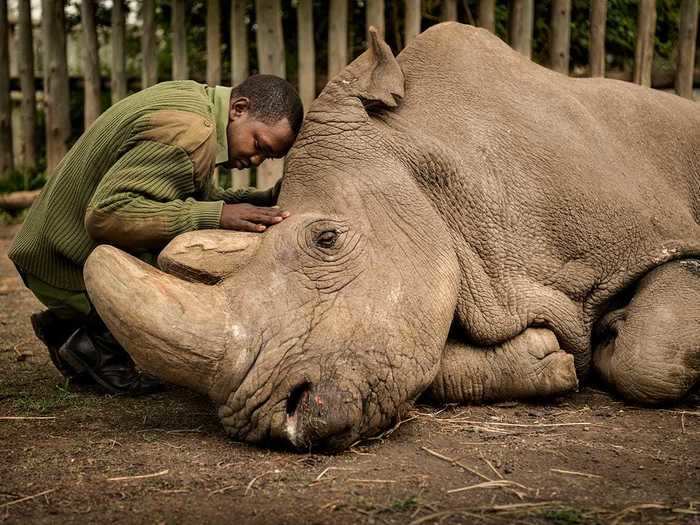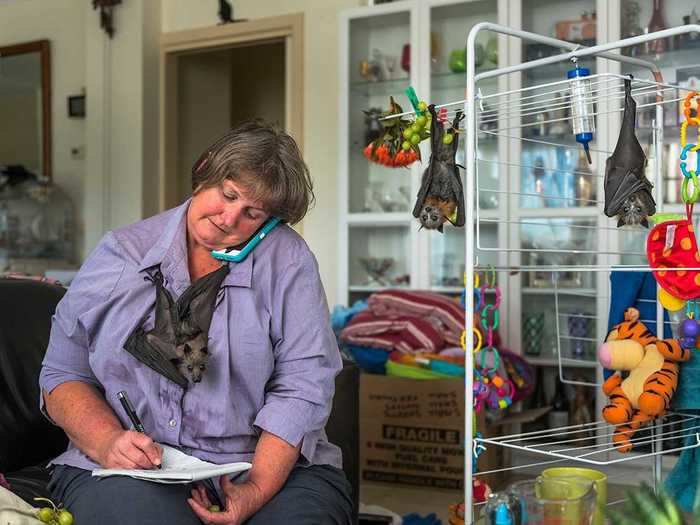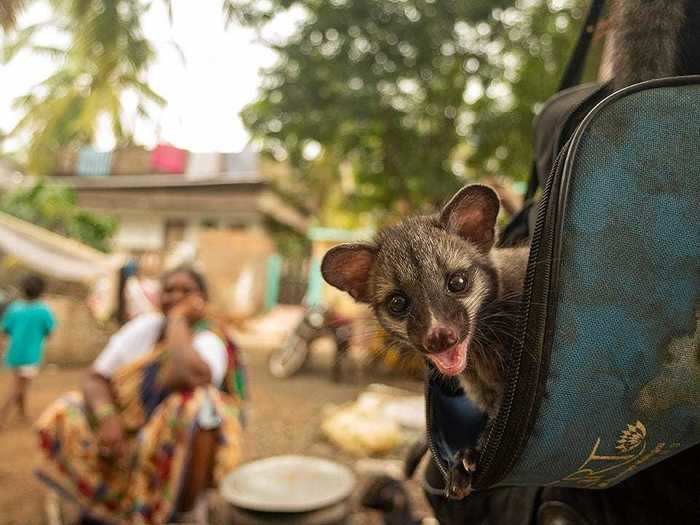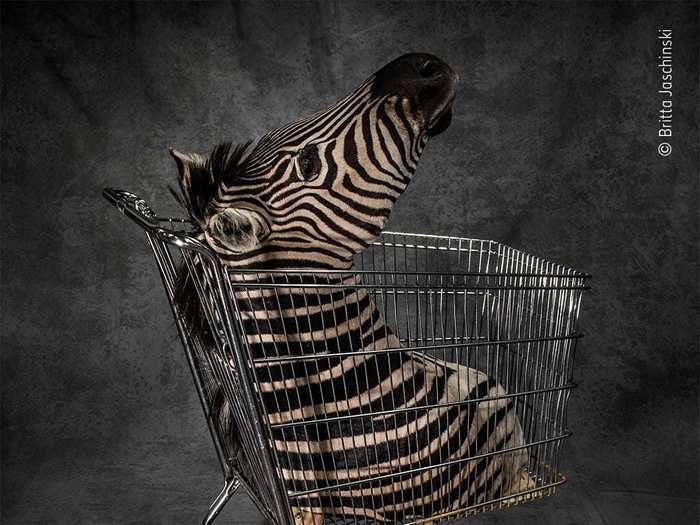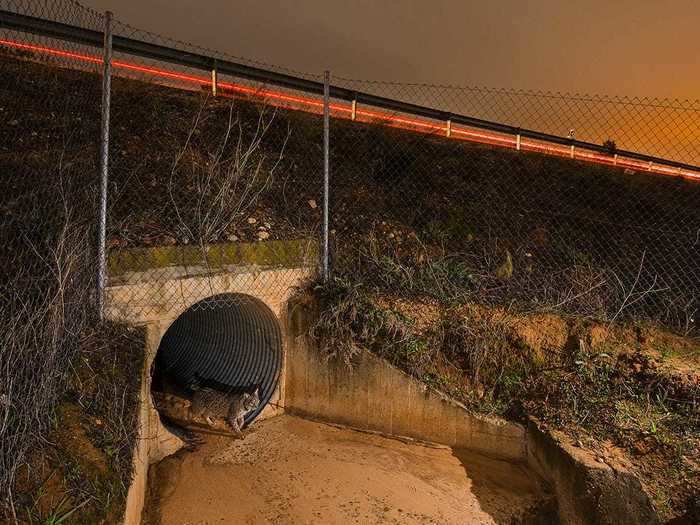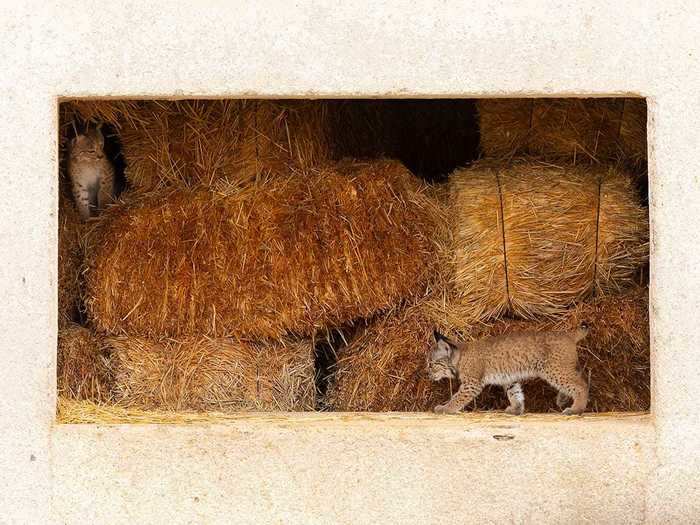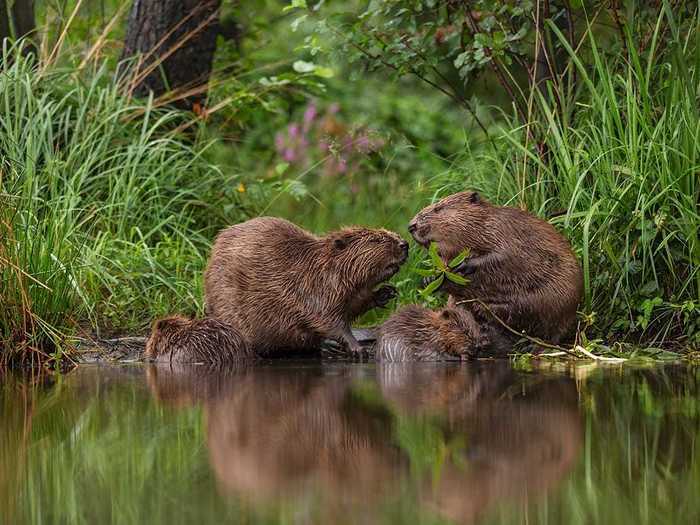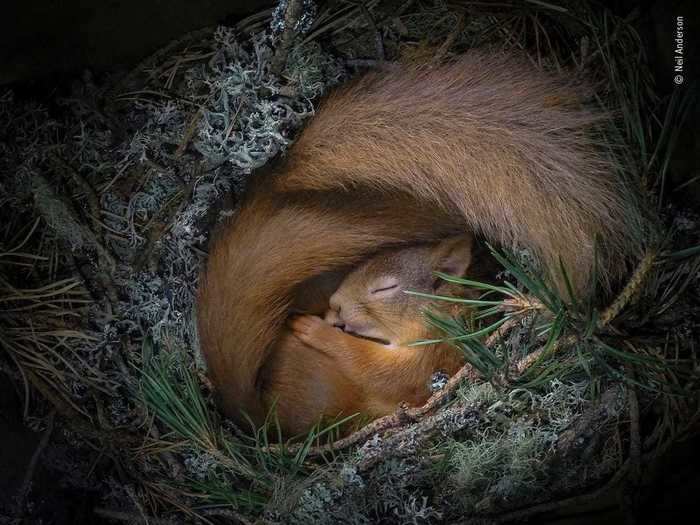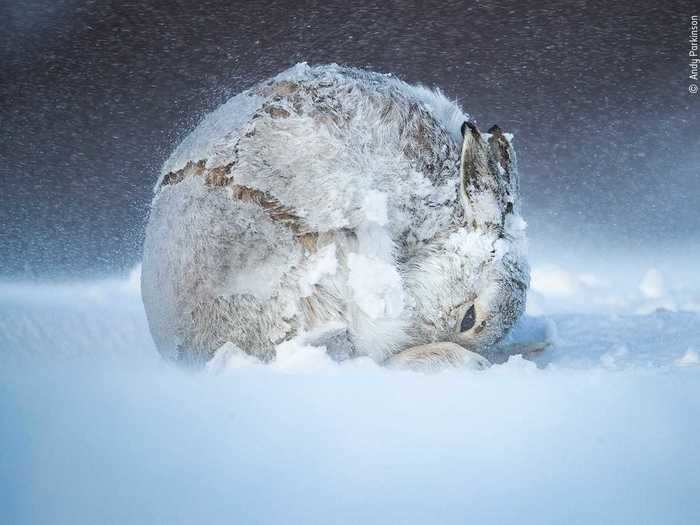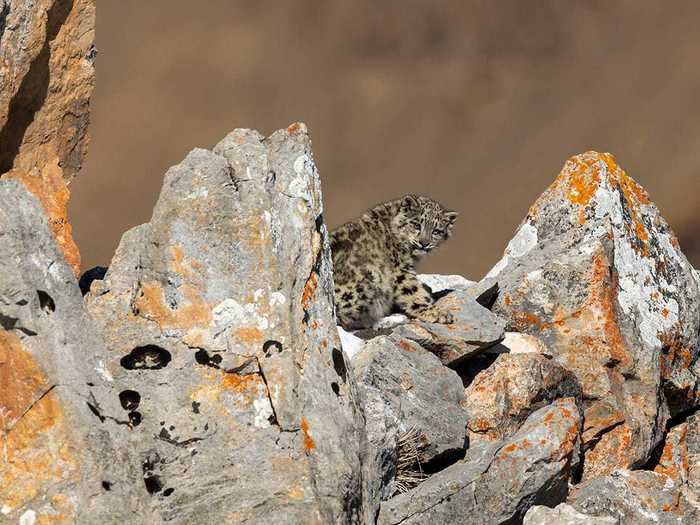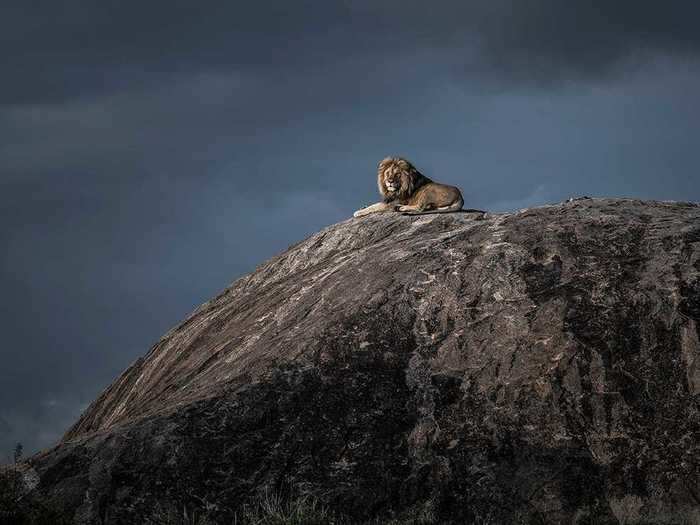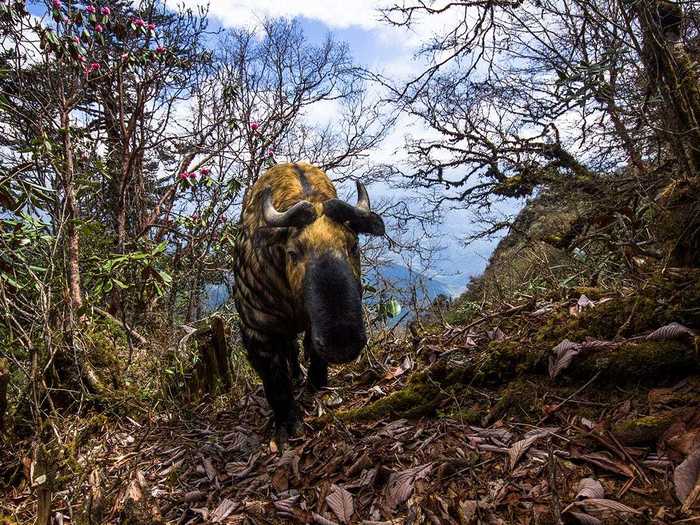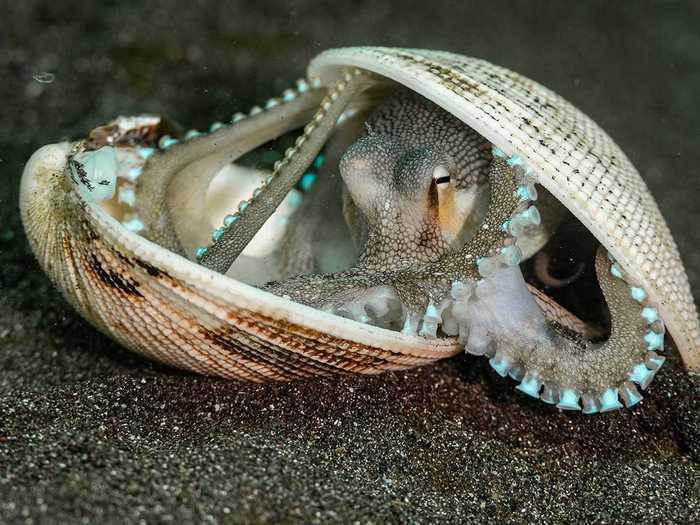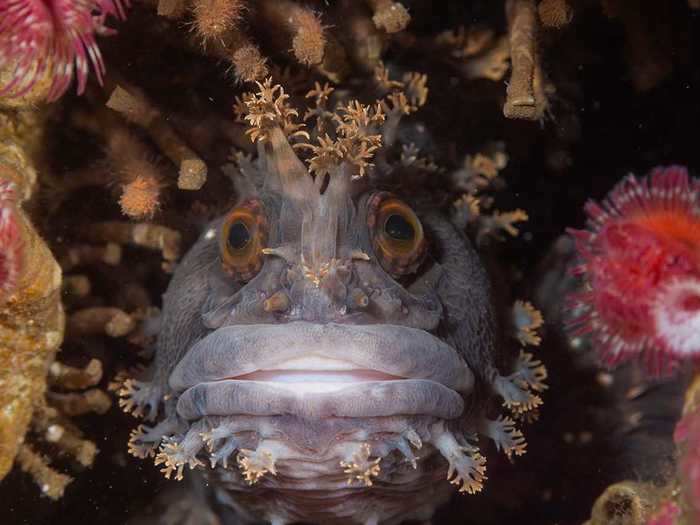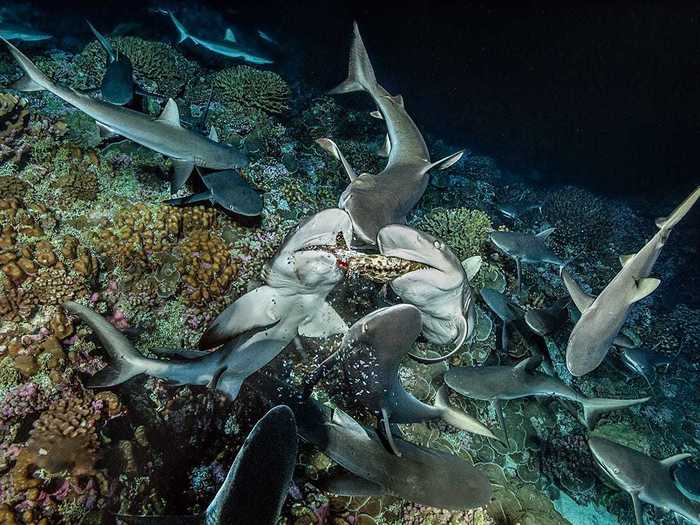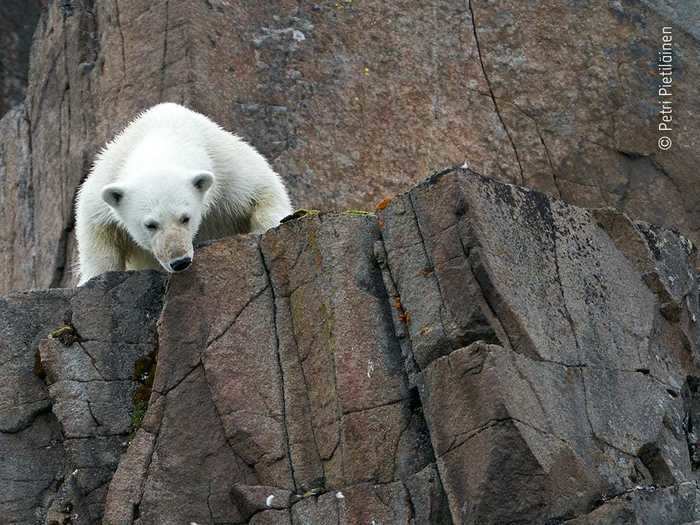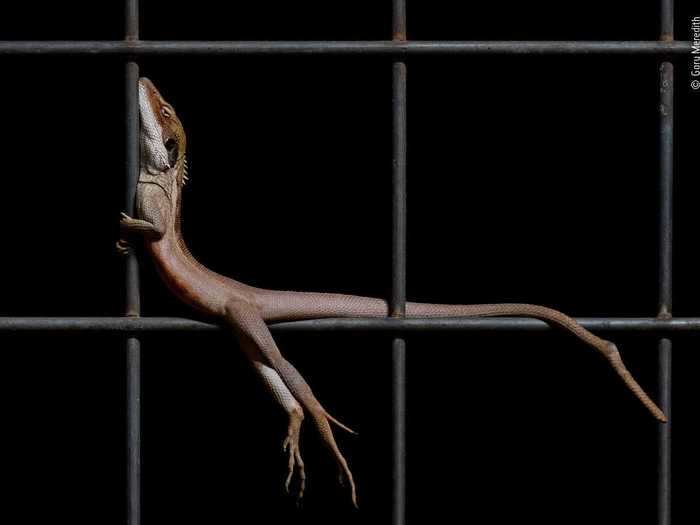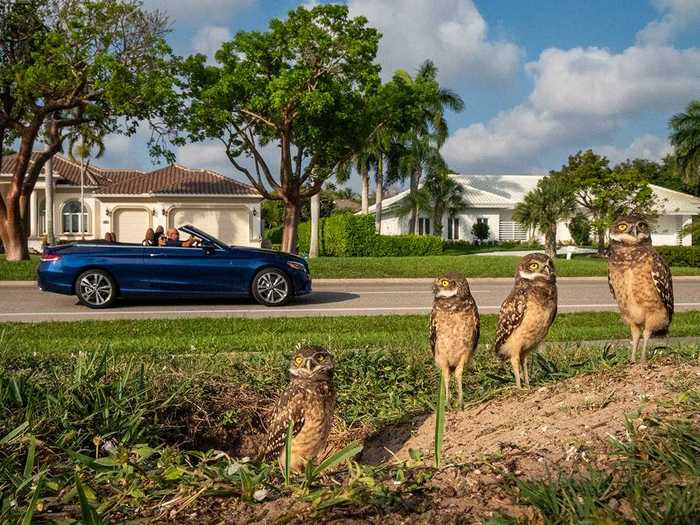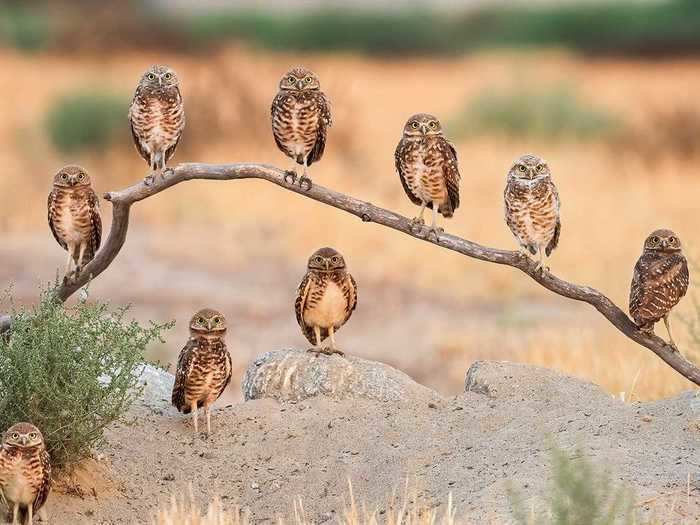A moose at Antelope Flats in Grand Teton National Park, Wyoming.Guillermo Esteves/Wildlife Photographer of the Year
- The London Natural History Museum's annual Wildlife Photographer of the Year competition offers the public a chance to vote on their favorite images from the contest.
- The leading photographs show an Iberian lynx along a Spanish highway, a civet cat taking a backpack ride in India, and an animal rescuer caring for orphaned bats in Australia.
- Here are the frontrunners for the 2020 people's choice awards contest.
On the side of the road in Grand Teton National Park, a bull moose and a dog engaged in a stare-down.
Photographer Guillermo Esteves had been hoping simply to snap a picture of the moose, but couldn't resist capturing this tense moment on camera. The car's owner — and furry co-pilot — were forced to wait until the moose lost interest and moved off the road.
Esteves' image is among the most popular wildlife photos of 2020.
Each year, the Wildlife Photographer of the Year contest offers a peek into the lives of species around the world. The competition is developed and produced by the Natural History Museum in London. It aims to award photographers whose work inspires us to consider our place in the natural world and our responsibility to protect it.
This year, photographers from 25 countries submitted 50,000 entries. Contest judges announced a group of winners in October, but now the public gets to choose favorites.
The contest organizers curated a shortlist of front-runners for these people's choice awards. Many of the images — including shots of an endangered Iberian lynx along a highway, a civet cat taking a backpack ride in India, and an animal rescuer caring for orphaned bats in Australia — throw into sharp relief the relationships between animal species and the humans around them.
Voting is open through February 2, after which the winners will be announced.
Below are 20 leading photographs from this year's people's choice awards contest.
Some of this year's leading photos showcase the bond between people and the animals they care for.
Joseph Wachira comforts Sudan, the last male northern white rhino left on the planet, at Ol Pejeta Wildlife Conservancy in northern Kenya.
Ami Vitale/Wildlife Photographer of the Year
Photographer Ami Vitale titled this image "The Last Goodbye." It shows caretaker Joseph Wachira comforting Sudan, the planet's last male northern white rhino. The photo was taken moments before Sudan died due to age-related complications at the Ol Pejeta Wildlife Conservancy in Kenya.
Julie Malherb, the wildlife rescuer and "bat woman" featured in this photo, cares for orphaned flying-foxes.
Wildlife rescuer Julie Malherb takes a call while looking after three grey-headed flying-foxes in Australia.
Douglas Gimesy/Wildlife Photographer of the Year
Flying-foxes are bats native to Australia's southeast forests. They were recently listed as vulnerable to extinction due to habitat loss and heat-related mass die-offs — problems exacerbated by the continent-wide bush fires that occurred in January.
The relationship between Russian bear trainer Grant Ibragimov and his animals is more complicated.
Bear trainer Grant Ibragimov with his bears at the Saint Petersburg State Circus in Russia.
Kirsten Luce/Wildlife Photographer of the Year
At the Saint Petersburg State Circus, Ibragimov performs a daily act with three Siberian brown bears. The bears are chained by their necks to a wall when they are young to strengthen their leg muscles so that they learn how to walk on two feet, according to photographer Kristen Luce.
This orphaned civet kitten grew up in a remote Indian village, where locals have kept it company.
An Asian palm civet kitten peeps from a bag in remote India.
Pallavi Prasad Laveti/Wildlife Photographer of the Year
According to photographer Pallivi Prasad Laveti, cat-like civets are often captured and kept in cages at Kopi Luwak coffee production plants. The coffee is made from beans that are partially digested and then pooped out by civets; trapped civets are often force-fed a diet of only coffee beans.
Not all of this year's photos show live animals.
A zebra head confiscated at a US border check point.
Britta Jaschinski/Wildlife Photographer of the Year
Britta Jaschinski snapped a photo of a confiscated zebra head at a US border checkpoint. Most likely, Jaschinski said, the hunters couldn't show proof they killed this zebra legally.
Humans — drivers, not hunters — also kill lynx like the one pictured here. More than 34 were run over in 2019 near where photographer Sergio Marijuán Campuzano took this shot.
A female Iberian lynx near a highway in Jaen, Spain.
Sergio Marijuán Campuzano/Wildlife Photographer of the Year
Iberian lynx are endangered and can become casualties of car accidents in places like Jaen, Spain as they try and expand their habitats. However, tunnels under highways and fencing improvements have decreased lynx mortality on the roads.
Some Iberian lynx are thriving, though, like these two kittens, Quijote and Queen.
Two Iberian lynx kittens play in a hayloft in Sierra Morena, Spain.
Sergio Marijuán Campuzano/Wildlife Photographer of the Year
The photo shows the two happily playing in a hayloft. Their mother, Odrina, and grandmother, Mesta, were born in the same hayloft, too.
Many of the frontrunner photos showcase animals going about their regular routines.
Two European beavers near Grimma, in Saxony, Germany.
Oliver Richter/Wildlife Photographer of the Year
Photographer Oliver Richter enjoys watching the European beavers by his home in Grimma, Germany, near Saxony. This image shows his backyard critters' favorite feeding place.
This photo shows two red Eurasian squirrels (one is obscured by his nest buddy) sleeping soundly.
Sleeping Eurasian red squirrels in a nest in the Scottish Highlands, UK.
Neil Anderson/Wildlife Photographer of the Year
The weather in the Scottish highlands can get chilly, so Neil Anderson put out a box in a pine tree near his home.
Two squirrels chose to make the box their home, and Anderson snapped a picture of them.
Not all animals in the Scottish highlands get so lucky, though.
A mountain hare near Tomatin in the Scottish Highlands, UK.
Andy Parkinson/Wildlife Photographer of the Year
This female mountain hare balled up tight to escape the chill from 60 mph winds near Tomatin. Photographer Andy Parkinson had to wait almost an hour in the freezing cold to capture the shot.
Photographer Frédéric Larrey also braved chilly weather to take this photo on the Tibetan plateau.
A snow leopard cub on the Tibetan plateau.
Frédéric Larrey/Wildlife Photographer of the Year
He was able to capture an image of this six-month-old snow leopard cub among the rocks after it stopped following its mother.
Snow leopards aren't the only big cats that climb among the rocks.
A huge male lion lying on a rock in the Serengeti plains of Tanzania.
Wim van den Heever/Wildlife Photographer of the Year
Wim van den Heever snapped a portrait of this male lion atop a large granite rock on the plains of the Serengeti in Tanzania.
Emmanuel Rondeau got a pleasant surprise when he found a shot of this curious takin among the photos in his camera trap high in the Bhutanese mountains.
A takin from the Bhutanese mountains.
Emmanuel Rondeau/Wildlife Photographer of the Year
Takins are also known as goat antelope. They can leap nimbly from rock to rock and are well-equipped to deal with the high altitude and cold of the Himalayas.
This photo of a coconut octopus shows how the eight-armed swimmers are smart and resourceful.
A coconut octopus in the waters of the Lembeh Strait in Sulawesi.
Sam Sloss/Wildlife Photographer of the Year
At the bottom of the Lembeh Strait in Sulawesi, this octopus was carrying its house made of shells when Sam Sloss took its picture. Some coconut octopuses use clam shells, coconuts, and even glass bottles to take shelter or conceal themselves from predators and prey.
This swimmer makes no attempt to hide.
A Japanese warbonnet fish from the Gulf of Oprichnik in the Sea of Japan.
Andrey Shpatak/Wildlife Photographer of the Year
Japanese warbonnets like this one, photographed off the coast of Japan, often swim right up to divers. The fish use sharp-edged jaws to snap up and swallow sea cucumbers and gastropods.
Grey reef sharks prefer to eat fish.
Two grey reef sharks munch on grouper fish in the waters of the Fakarava Atoll in French Polynesia.
Laurent Ballesta/Wildlife Photographer of the Year
This photo shows two sharks munching on grouper fish flesh in French Polynesia. These predators hunt in packs but do not share their prey.
Polar bears hunt solo. It took this bear several tries to finally catch a barnacle goose in Svalbard, Norway.
A polar bear hunts barnacle geese in the Norwegian archipelago of Svalbard.
Petri Pietiläinen/Wildlife Photographer of the Year
According to photographer Petri Pietiläinen, this bear had a hard time making its way down the steep cliff to reach the geese nesting below.
Some geese and their chicks jumped off the cliff, but the bear fed on the animals that remained behind.
Some animals aren't bothered by proximity to people, and even take advantage of it.
A long-nosed dragon in the Great Sandy Desert of western Australia.
Gary Meredith/Wildlife Photographer of the Year
Long-nosed dragons lounge on the wire mesh outside mining workshops in western Australia's Great Sandy Desert. That way, the lizards can easily catch some sun and munch on the insects attracted to the workshops' artificial lights.
Burrowing owls like these love to take up residence in meticulously manicured lawns on Florida's Marco Island.
Burrowing owls on Marco Island, Florida.
Karine Aigner/Wildlife Photographer of the Year
The owls dig holes into the yards of luxury resorts and multimillion-dollar homes, where they hunt for insects and lizards.
California, too, is home to burrowing owl families.
A family of burrowing owls in Ontario, California.
Andrew Lee/Wildlife Photographer of the Year
These owls live in the urban sprawl of Ontario, California. Photographer Andrew Lee had to wait several days to get the entire family — two parents and their eight chicks — on film.

